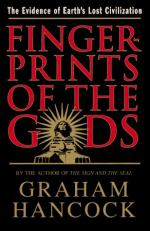
|
| Name: _________________________ | Period: ___________________ |
This test consists of 15 multiple choice questions and 5 short answer questions.
Multiple Choice Questions
1. What did Hancock's researcher conclude in Chapter 50?
(a) A lost civilization was supported by a landmass.
(b) The lost civilization still exists.
(c) There was definitely a lost civilization.
(d) There was no lost civilization.
2. How high is the entry to the Great Pyramid?
(a) 3 feet 6 inches.
(b) 36 yards.
(c) 36 meters.
(d) 36 feet.
3. What did the Sun God, Ra, do?
(a) Give orders to lesser gods.
(b) Sit on a throne surrounded by lesser gods.
(c) Control darkness and light.
(d) Control the movement of the stars.
4. What did Hancock wonder about the Great Pyramid in Chapter 37?
(a) Why the builders used such imprecision on a tomb.
(b) Why the pharaoh was buried in a pyramid.
(c) Why the builders used such precision on a tomb.
(d) Why the pyramid was not used to bury a pharaoh.
5. When is it believed that the Great Pyramid was built?
(a) 4,500 B.C.
(b) 5,000 B.C.
(c) 4,000 B.C.
(d) 5,400 B.C.
6. How frequently do the planets line up in the order, on the same date, that the Mayans predicted the Fifth Sun ends?
(a) 4,200.
(b) 45,200.
(c) 4,000.
(d) 45,000.
7. How much does the average block of the Great Pyramid weigh?
(a) 3.5 tons.
(b) 200 pounds.
(c) 2.5 tons.
(d) 300 pounds.
8. What fits the Earth-displacement theory in Chapter 50?
(a) An outline about Antarctica.
(b) A map of Antarctica.
(c) An outline of the South Pole.
(d) A map of the South Pole.
9. In Chapter 38, how did Hancock observe the Great Pyramid?
(a) From a plane.
(b) Through passageways from room to room.
(c) From the top.
(d) From the base.
10. What did sacred writings offer evidence of in Chapter 41?
(a) No technological skills.
(b) Expected advanced technological skills.
(c) Unexpected advanced tehnological skills.
(d) Limited technological skills.
11. How many degrees are allocated on the elliptic for each constellation?
(a) 60.
(b) 360.
(c) 72.
(d) 30.
12. How large is the base of the Great Pyramid?
(a) 13.1 meters.
(b) 3.1 meters.
(c) 3.1 acres.
(d) 13.1 acres.
13. Who were Palermo Stone and Turin Papyrus?
(a) Gods.
(b) Kings during the First Dynasty.
(c) Kings before the First Dynasty.
(d) Kings after the First Dynasty.
14. Who is Jane Sellers?
(a) An explorer.
(b) A geologist-astronomer.
(c) A socio-astronomer.
(d) An archaeo-astronomer.
15. What is the "Great Return"?
(a) The end of the Ice Age.
(b) A complete precessional cycle.
(c) A migratory pattern.
(d) The tale of Osiris.
Short Answer Questions
1. What is surprising about the granite used to sculpt the Second Pyramid?
2. What did the Ancient Egyptians understand well, according to Chapter 42?
3. How far does the sun migrate in 72 years?
4. How are the stars Sirius A and B related?
5. What is one element of the author's thesis in Chapter 52?
|
This section contains 492 words (approx. 2 pages at 300 words per page) |

|




